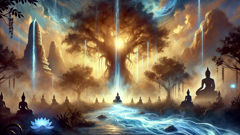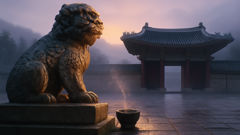Introduction
On a slope of the world where the river met a ruined terrace and ancient trees leaned like old sentinels, the earth kept a secret she had carried since before names were sewn into the sky. Villagers in that valley still whisper the story when they sweep temple steps and when rain fills the ceramics by the home altar: how Phra Mae Thorani, the earth goddess, rose from the soil to answer a plea that was older than sorrow. The tale begins in the hush that gathers beneath the Bodhi tree, when a man seeking truth sat unmoving and the heavens watched. Mara, the tempter who would unseat resolve with desire and dread, pressed forward with armies and illusions. He unleashed his mocking princes, his clamoring elephants, and his storm of doubts to fracture the calm of the one called the Buddha. Where power met gentleness, where intent met history, Phra Mae Thorani felt the tremor in the ground: a call not only from a single man but from the promise of awakening itself. This myth, told in carved gables and gilded murals across Thailand, is more than spectacle. It binds together human striving and the patient, sustaining ground beneath our feet. It names an ethical geography—how courage can be both a quiet grounding and an eruption of force, how the earth can be guardian and witness. Across centuries, artists have painted her with a palm leaf of rice paddy green and hair like braided midnight, and monks have pointed to her figure to explain that moral strength sometimes needs the unglamorous, steady heft of soil. In this retelling I will walk through the scene by the Bodhi, linger by the river of images in Thai temples, and listen to the measured drip of that hair-wrought flood. We will meet Mara in his swelling vanity, the Buddha in his stillness, and Phra Mae Thorani in a gesture both intimate and cataclysmic—wringing her long hair until the water of the earth pours down like a verdict. Alongside the narrative, we'll explore the symbol's meanings: the water as testimony, the wringing as witness, the earth's reply as the indispensable force that protects truth from being smothered by illusion. This is a story about protection, purification, and the unexpected ferocity of gentleness, told so the myth may speak again to anyone who stands, in their own time, at the threshold of choice.
The Meeting under the Bodhi Tree: Mara, the Buddha, and the Earth
The story begins in a quiet valley that knows the rhythm of seasons by the sorghum and by the slow creak of ox carts. Men and women who lived near the Bodhi grove told it to children as they fixed their thatch and to travellers as they offered a bowl of rice. The Bodhi tree itself was an elder—its bark folded with time, its roots like the veins of the ground. Under this tree the figure who would become the Buddha sat with a gathered patience, an intent that was not empty and not aggressive but full of an unflinching attention. As his concentration deepened, as questions that tug at all hearts were met and gently unwound, Mara saw a threat to his realm: not merely a threat to pride but to the business of disorientation that sustained his power. The description of Mara in the oldest tellings is not a simple caricature of evil. He is a complex force that uses desire, fear, and pride to turn people away from clarity. Some stories give him armies—riding beasts, specters of desire, rills of temptation. Others speak of him as an unkindly wind that pushes a person from their path. On that day at the Bodhi, Mara gathered his retinue and rode toward the tree like a cloud of accusation. He hurled toward the meditating figure everything he commanded: gold and servant daughters, visions of sumptuous palaces, offers of worldly reign. He sent illusions that made the air tremble, stirring images meant to dislodge calm. But the meditating figure did not rise. His purpose had roots as deep as the tree's roots. Mara moved to use a final stratagem—the oldest and most damaging: to sow doubt. With his voice and with the sharp show of his power, he accused the meditator of arrogance, of falseness, of presumption. He summoned witnesses and conjured memories meant to throw that steady heart into the corridor of self-questioning. It was in that moment, in the hush when breath and history met, that the ground answered. From the earth itself rose a presence who was older than kingdoms and softer than the first rain: Phra Mae Thorani, the mother of the soil, the guardian of testimony. She did not shout or wage battle with spear or flame. Instead she placed both palms on the earth and drew from its depths a witness. In many depictions she appears as a woman of calm, a figure carved on temple pediments with a broad face, eyes like quiet ponds. Her hair is always depicted extraordinarily long, braided or loose, and in the myth it is this hair that holds a secret utility—the ability to gather and release the water that flows through the ground, the water of all witness and all memory. When she steps forward the world seems to hold its breath. The goddess looks at Mara without fury like one who has seen cruelty before and will not be surprised into retreat. She then gathers her hair, and with an action that is at once domestic and world-altering, she wrings it. Where human hands might wring a cloth or wring a soaked basket, hers wrings the memory of rain and the water of testimony. From her braid pours water—a river that is the water of the earth itself, the accumulated truth of every footprint, echo, and oath that the soil has held. This flood is not merely a physical element; it is a juridical element. In Southeast Asian symbolic thinking, water often stands for cleansing and revelation. The water that Phra Mae Thorani releases is a testimony against falsehood, a clarifying flood that washes away illusions and exposes the bones of reality. Mara's images, grand as they are, dissolve before such elemental honesty. The goddess' stream washes over his army of illusions and leaves them as nothing, like dust drifting off a costume. Where Mara had used spectacle to hide emptiness, the earth used the plain fact of wetness and gravity to remind the world of what endures. The Buddha remained unmoved in body and untempted in will, but the crucial drama was not his composure alone. It was the earth—Phra Mae Thorani—declaring herself witness, offering the weight and continuity of the ground in favor of truth. People who built temples in later centuries carved this scene into stone and lacquered it with gold, because it names a fundamental moral geometry: truth is not self-evident; it must be witnessed, defended, and given a place in the public world by forces both grand and steady. Through the ages, Thai painters and muralists painted the scene with saturated color. They framed Phra Mae Thorani as simultaneously maternal and formidable, because the myth invites us to consider motherhood not as soft helplessness but as a source of elemental intervention. Parents who tell the story to children sometimes emphasize the gentle protection; meditative teachers focus on the water as the clearest symbol of purified witness, and cultural historians point to how this moment creates an axis—a meeting of human determination and a broader, sustaining cosmos. The episode is taught as a story of alliance: the moral action of a person in meditation does not stand alone but is supported by the larger moral order, by Earth's memory and willingness to testify.

In that moment, as the goddess wrung her hair and the water rushed like proof, Mara's own self began to collapse. His weapons turned to mist; his accusations slithered and left nothing, because what the water revealed was not only the meditator's purity but also the hollowness that sustained Mara himself. The psychology of the myth is telling: temptation collapses when met by clear witness. The earth does not condemn; she clarifies. She does not triumph through anger; she clarifies through physical, indisputable fact. The water is the world's seal—an old, unassailable witness. For villagers, for temple goers, this image holds a practical lesson: when actions are right, the world will provide testimony. Not in an automatic, easy way, but in deep, patient, sustaining evidence. And so the story closes that scene with Mara retreating, with the Buddha's attainment preserved, and with Phra Mae Thorani returning to the soil, her duty fulfilled for a time. Local storytellers will add details—how the frogs paused in their chorus, how pigeons folded their wings, how a distant bell seemed to toll at once for the whole valley. These flourishes are not meaningless; they perform the same function as the goddess's water, adding communal witness: memory multiplies memory, and by telling the tale we continue the earth's testimony.
Symbol, Ritual, and Reverence: How Phra Mae Thorani Lives in Thai Culture
The myth of Phra Mae Thorani is not merely a story told to children; it is a living emblem woven into the rituals, art, and moral language of Thai Buddhism. Walk into a provincial temple and you will find her image folded into the architecture: a low-relief carving on the base of an ordination hall, a gilded painting behind the principal Buddha, or an embroidered patch on a monk's offering cloth. Each representation carries layers of meaning that connect doctrine to everyday life. First, consider the symbolism of water. In the Southeast Asian religious imagination, water is double-sided: it nourishes and it bears witness. Rice paddies depend on it, ceremonies request it, and rites of purification demand it. In the Phra Mae Thorani episode, water functions as both sustenance and juridical force. It washes away illusion and testifies to the meditator’s merit. Devotees, when they see the goddess in paintings, often say the scene reassures them: truth will have its tide. This reassurance has a social application. In a community, honor and reputation can be fragile; accusations can damage someone's standing. The Phra Mae Thorani story gives people a moral grammar: if one acts with integrity, the earth itself will, in the long view, provide verification. This does not mean injustice never happens; the myth does not insist on immediate recompense. Instead, it offers a deeper ethical horizon: that the ground remembers, and when truth is necessary for the protection of awakening or virtue, the earth will lend itself as witness. The practical influence of this belief appears in ritual life. During ordinations and important ceremonies, offerings are made to the earth and laments for transgressions are spoken aloud; the community expresses a recognition that human words alone are not enough, and that ceremonies must invoke the wider world to create moral facts. A monk may touch the ground during an ordination vow, not as a superstitious gesture, but as an appeal to the same continuity that Phra Mae Thorani personifies—the call for the land to witness and sustain the intention. Traditional artists have also turned the goddess into a pedagogical tool. In murals where scenes from the Buddha's life are painted, the episode of Phra Mae Thorani is often placed at the ordination hall's base, reminding novices of the gravity of their vows. The iconography she carries is specific: hands touching earth, hair long and full, water pouring in bright arcs. These visual cues help a viewer recognize the episode and recall its meaning. The art is not merely illustrative; it is performative. When a villager sees the goddess painted near the hall where monks gather, the painting begins to function like an enactment: it joins the congregational moment and the personal oath, reinforcing the sense that moral truth is witnessed by more than by human circles. Beyond ritual and art, the myth has a practical resonance for those who tend the land. Farmers who depend on the cycles of wet and dry have a daily intimacy with water's power; they understand that water can build or ruin. To them Phra Mae Thorani is not an abstract guardian but a metaphor for the earth's responsiveness. When irrigation systems fail or when floodwaters surge, older people sometimes speak of the goddess in pragmatic terms—as if she has moved or rested. This is not mere personification. It is an acknowledgment of interdependence: humans rely on earth's favor, and so one way to think ethically about natural resources is to imagine the earth as a living presence worthy of respect. In modern Thailand, the goddess has also been adapted into civic and cultural narratives about environmental stewardship. Conservationists sometimes invoke her as a symbolic call to protect the land and its waters, because the story resonates with widely held intuitions: the earth remembers, and her memory is a moral force. Such invocations can be persuasive because they translate an ancient religious image into a contemporary policy imagination—reminding people that neglecting the land is not only a technical failure but also a moral misalignment. Another dimension lies in gendered readings of the myth. Phra Mae Thorani is a female figure who acts decisively in a public moral crisis. Across history, female divinities often encoded ambiguous powers: nurturing and destructive, gentle and formidable. The earth goddess reframes maternal metaphors—she is not limited to passive support but becomes an active agent in the preservation of awakening. This has made her a figure of empowerment in some modern cultural conversations: she offers a source of female power that does not reduce to domesticity. In art, she is both motherly and monumental. The way artists present her—sometimes with a gentle smile, sometimes with a stern face—reflects the social values they wish to emphasize. For monks teaching meditation, the episode is a practical lesson about witness. They instruct students that inner calm is not simply silence; it is testimony that must be recognized by a broader truth. Simultaneously, the myth addresses the inner struggle people face: temptation and self-doubt do not merely come from without; they also arise from within. Mara's forces are internalized—attachments, aversions, false identity. Phra Mae Thorani's water washes away those specters, but the washing itself is not a miracle that bypasses effort. The meditator's steadiness is required; the goddess's intervention complements, it does not substitute. This gives the story a balanced moral: personal effort and supportive witness together secure ethical results. In contemporary storytelling and popular media, the goddess continues to appear. Filmmakers will use her image in scenes that require a cultural shorthand for authenticity or a reminder of moral gravity. Craft artists reproduce her in silver and wood; storytellers fold her into children's books that emphasize courage, and scholars analyze the scene in essays that trace its textual lineage through Pali sermons and folk histories. The multiplicity of uses testifies to the myth's adaptability—its ability to speak to ritual piety and to environmental ethics, to art and to pedagogy, to gendered power and to meditative discipline. Through every ray of adaptation runs the same central image: a woman of the earth, hair full of water, making of the ground a witness that drowns deception and sustains truth. That image continues to shape how people in Thailand imagine the relationship between moral action and the world that bears it.

Conclusion
The story of Phra Mae Thorani closes not with final triumph alone but with a lasting contract between human striving and the patient constancy of the earth. When the goddess wrung her hair and the water poured like an undeniable testimony, she did more than save a single moment of awakening: she established a model for how truth can be supported by something older and wider than human caprice. Across Thailand, through murals, rituals, and everyday speech, people continue to call upon that model. They place their palms to the ground, they make offerings, they carve the image into temple bases, and in these gestures they remind themselves of a crucial ethical lesson: the world is not neutral; it bears memory, and that memory can stand as witness when integrity meets trial. The myth's endurance lies in its capacity to translate the abstract into the sensorial—the way the world feels when water runs cold and honest over the hands. It is also lasting because it balances: a meditator's resolve is necessary; the goddess's intervention is crucial; together they show that courage and witness are not in competition but in coalition. In contemporary times—when conversations about environment, justice, and collective responsibility grow urgent—the tale of Phra Mae Thorani speaks with renewed clarity. It invites us to imagine the earth not as raw commodity but as an active moral presence whose testimony matters. It also invites us to think about how communities might call upon ritual and story to hold one another accountable in ways that are neither punitive nor naive. Ultimately this is a story for anyone who has sought clarity in confusion, for anyone who has wished for proof when words fall short. It is a parable of alliance—between the will to see clearly and the world that remembers. When you stand beside a Bodhi tree or trace a painted goddess on a temple wall, you encounter an invitation: to act with such groundedness that the earth will answer on your behalf, to be present in such a way that when history demands witness, the soil itself may give it.













